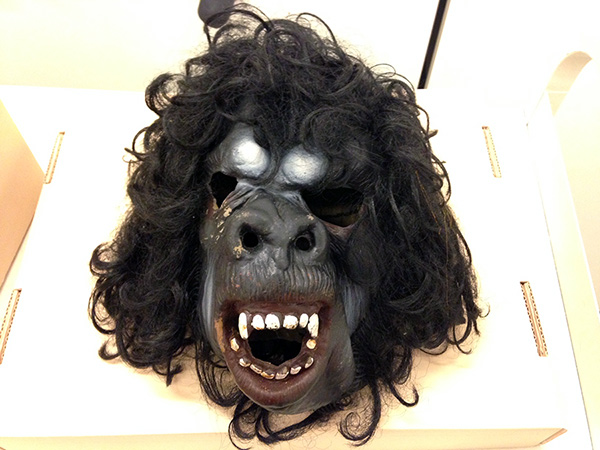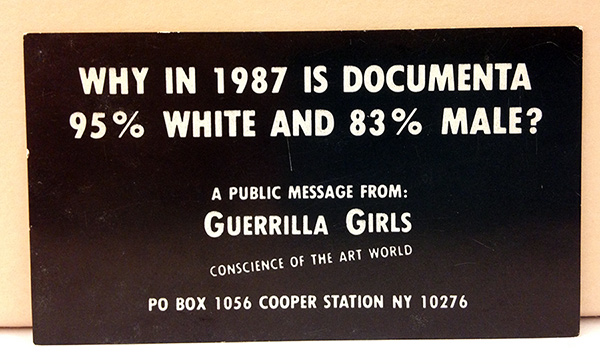What Did the Guerilla Girls Commonly Include in Their Art?

Props used in the Guerrilla Girls' actions: plastic gun, bananas, and gorilla fingers with nail smooth. The Getty Inquiry Institute, 2008.G.xiv. Copyright © Guerrilla Girls, courtesy guerrillagirls.com
In 1994 curator Marcia Tucker, whose papers are now held at the Getty Enquiry Institute, organized an exhibition at the New Museum in New York entitled Bad Girls. The show analyzed a wave of art from the 1980s and early on '90s dealing with feminist issues, presenting practices substantially different from those of the belatedly '60s and early '70s, the epoch commonly defined as l'âge d'or of feminist art. These bad girls, who were really also boys, were working on the same old issues of sex, gender representation, and the condition of women in lodge, simply with a new twist: they did not fear to go "too far," to be irreverent, unladylike, sometimes even vulgar. The bad girls were fun, were saying information technology all, and were maxim it correct in your face up.
The bear witness featured an bearding group of artists chosen the Guerrilla Girls, the "conscience of the art world" every bit they proudly called themselves. The grouping was formed in 1985 past art professionals wearing gorilla masks—what is more unladylike than a gorilla mask?—and calling themselves by the names of dead and largely underrated female person artists from all epochs: Rosalba Carriera, Käthe Kollwitz, Artemisia Gentileschi, and others. They used gorilla masks to help maintain focus on the issues they were presenting, rather than on their individual personalities and practices. Furthermore, the masks were a necessity, as they couldn't beget to lose their mean solar day jobs.

Mask used past the Guerrilla Girls in their actions. The Getty Enquiry Institute, 2008.M.14. Copyright © Guerrilla Girls, courtesy guerrillagirls.com
The Guerrilla Girls had good reason to fright for their jobs: the grouping began past covering Lower Manhattan walls with posters full of statistics about discrimination against women artists and artists of color, listing people'due south names and unquestionable, shameful facts. For example, the poster beneath listed the galleries in New York City devoting ten percentage (or even less) of their shows to women artists, while the calling carte du jour they distributed at documenta viii in 1987 exposed the fact that white and male artists dominated the puddle of artists in the exhibition.

"These Galleries Prove No More Than 10% Women Artists Or None At All," ane of the very outset posters plastered at night by the Guerrilla Girls in SoHo in 1985. The Getty Inquiry Constitute, 2008.M.xiv. Copyright © Guerrilla Girls, courtesy guerrillagirls.com

Guerrilla Girls' calling card passed out at the opening of documenta viii, Kassel, 1987. The card was kept by curator Harald Szeemann in his Creative person files. The Getty Enquiry Institute, 2011.Chiliad.30. Copyright © Guerrilla Girls, courtesy guerrillagirls.com
They then broadened their targets to include social and political issues such as abortion, gay and lesbian rights, the politics of the Bush-league era, and violence against women. The severe await of the posters, for the nearly part in black and white with no images, was at odds with what is traditionally labeled as "feminine," reproducing instead the cold aesthetics of (mostly male) conceptual art.
Compared with the works of other artists agile in the domain of institutional critique, the Guerrilla Girls' fine art reached a new level of aggressiveness in order to face up the cultural politics of art institutions in the '80s, which were far more than conservative than those of the previous decade. In addition to reaching their public by wild posting and mass mailing, the group started suggesting guerrilla actions in museums, such every bit using restrooms every bit exhibition spaces or correcting interpretive labels for paintings.

"Y'all're Merely Seeing Half the Motion-picture show" poster projection, 1989, Guerrilla Girls. The Getty Inquiry Institute, 2008.K.fourteen. Copyright © Guerrilla Girls, courtesy guerrillagirls.com
The Girls decided to go all the style, and take connected to do so e'er since: in their posters as well as in their performances, lectures, interviews, exhibitions, and publications, they have named names, showed numbers, quoted sources, and presented blank facts that the public is invited to elaborate. In The Guerrilla Girls Review the Whitney, a 1987 exhibition at Clocktower in New York, the group analyzed and exposed the politics backside the Whitney Museum, scrutinizing the choice of artists for the Biennale through the decades, the acquisition policy and the oftentimes not-so-transparent network of relationships (and money, lots of money!) among curators, sponsors, trustees, and politicians.

"Well Hung at the Whitney – Biennial Gender Demography 1973-87", draft for a poster featured in the exhibition The Guerrilla Girls Review the Whitney at the Clocktower, New York, 1987. The Getty Research Institute, 2008.M.14. Copyright © Guerrilla Girls, courtesy guerrillagirls.com
The Guerrilla Girls records at the Getty Research Institute, caused in 2008, include in nigh 100 boxes all the documents on the group's activities from 1985 to about 2003: the complete series of poster projects, research and administrative material on publications, exhibitions, lectures, and performances, and fifty-fifty gorilla masks, wigs, and bananas. The records correspond an invaluable source for the study of the evolution of feminist fine art and the sensation of women artists at large, and complement an already large trove of archives at the Enquiry Institute, such as the papers of Eleanor Antin, Yvonne Rainer, Carolee Schneemann, Sylvia Sleigh, and the newly acquired Barbara T. Smith archive.
We are still far from an equal lodge, and not only in the art world. That's why the "bad girls" are nevertheless out there, fighting for the time when their work will no longer be needed.
The Guerrilla Girls annal is bachelor for study past qualified researchers.

This postal service is role of the series Exterior the Box, presenting stories and unique finds from archives and special collections at the Getty Research Institute.
See all posts in this series »
Source: https://blogs.getty.edu/iris/treasures-from-the-vault-the-guerrilla-girls-archive/
0 Response to "What Did the Guerilla Girls Commonly Include in Their Art?"
Post a Comment